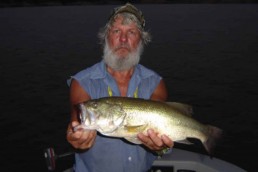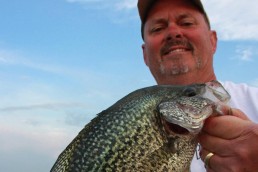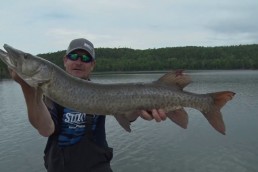Slide Deeper for Crappie Action in Hot Weather
SHARE THIS POST
The weather we were wanting back in December has finally arrived, but now we are complaining that it is too hot. Temperatures and humidity reaching highs that make you want to just sit in front of the air conditioner with a glass of lemonade are actually good days to be fishing for crappies.
Many fishermen believe that crappie fishing is a springtime activity that includes shallow water and brush piles, or other debris that crappies like to hide in or near. But, once crappies are done spawning, they move back out to deeper water and seem to drop off the minds of most anglers. Do not fall into that category.
For those anglers that still pursue pie-plate size slabs in the heat, they know two things that many fishermen do not. Fish, crappies included, still have to eat no matter what the thermometer says. Secondly, a lot like whitetail deer, crappies have a summer pattern that they rarely change. If you know their habits, hangouts and the right methods to fish for them, you will be able to catch your limit.
Finding deeper, cooler holes in the lake will hold many crappies after spawn. The depths of these holes vary from lake to lake. These holes could be as deep as 20 to 30 feet deep surrounded by flats that are only two or three feet deep. It is not always necessary to fish the deepest parts of these holes. Crappies are likely to be found on the sides of these holes in the 10- to 15-foot range. It will take some time to find the depth of these schooling fish, but once you do, drop the anchor, and lines and bait and start catching fish.
Crappies are going to be holding tight to certain attractions on the holes, like points or several stumps in a group. Finding these features often means finding fish as well.
Finding these fish will require studying a good topographical map of the lake that are available online or most local bait shops will have them. When studying the map, look for bars and creeks along a main river channel. After discovering what are possibly good spots on the map, you need to get in the boat and use your electronics.
Are you enjoying this post?
You can be among the first to get the latest info on where to go, what to use and how to use it!
When you locate a drop-off, mark it with floating markers for about a 75-yard distance. With the markers in place come back and slowly take your boat over the area looking for crappie-holding features with your LCD depth finder. Like most species of fish, crappies are likely to be found where baitfish are, so keep an eye open for baitfish on your depth finder too.
Other good locations to search out summer crappies are boat docks. Many private boat docks have had brush piles sunk near them by their owners.
As with all summer crappie fishing, this tactic will also require a good depth finder. Search out brush piles near the end of docks that are also near the old river channels in about 20 feet of water. A good topographical map will show you where these channels are. I have found the best way to find these are to simply drive slowly with one eye on the screen of your LCD.
It is also easy to spot which docks might have brush piles. Look for docks that have rod holders, lights and other fishing related equipment on it. This is a sign that the owner of the dock is fishing the water and might be worth you exploring.
When I find a brush pile I put my boat right on top of it. I do not use heavy equipment. I stick with four-pound-test line, a number 8 hook and a BB split shot about six inches above the hook. On the hook is a live minnow hooked through the lips fished vertically above the brush. Sometimes I also use a 1/4-ounce lead head and a tube jig body and even at times a two-hook crappie rig baited with live minnows. Feeling for cover with the jig or sinker lets me know I am fishing in the right area.
Summer crappie fishing is not like spring crappie fishing. Change tactics by moving to deeper water and using your LCD like your fishing success depends on it. Actually, it does depend on it.
MWO
SHARE THIS POST
Did you enjoy this post?
You can be among the first to get the latest info on where to go, what to use and how to use it!
Jason Houser
Jason Houser is an avid outdoorsman from Central Illinois. Houser has been a full-time freelance writer since 2008. He is also the host of Jason Houser Outdoors, airing on the Hunt Channel. He can be found on Facebook at Jason Houser Outdoors or on the web at jasonhouseroutdoors.com.



